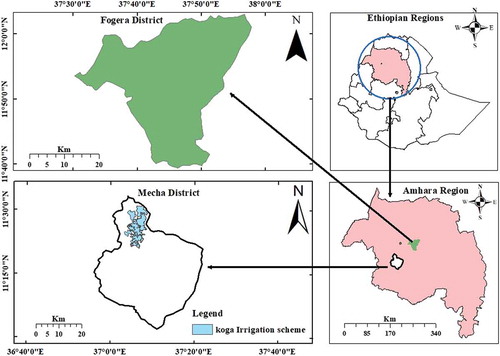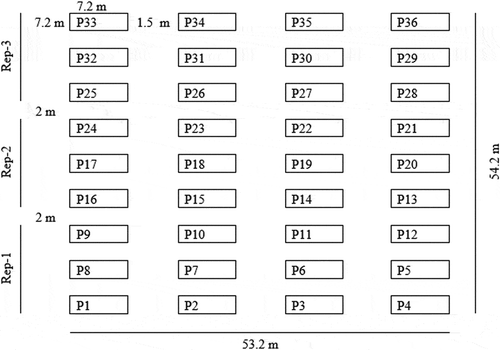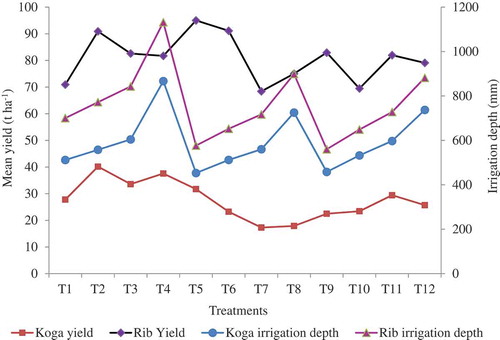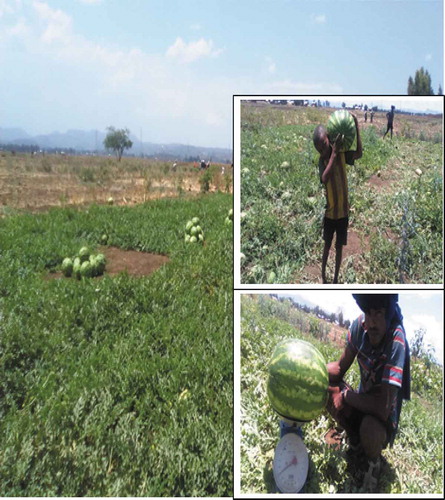Abstract
Determining the optimum crop water requirements is considered one of the most important factors affecting plant productions. Excessive application of water can damage watermelon and face fruit quality with problems, leading to a reduction of the melon fruit yield, lower fruit quality characteristics, and plant disease. Therefore, the main objective of this study was to determine the crop water requirement of watermelon in a field experiment using the CROPWAT model at Koga and Rib irrigation schemes. The experiment was conducted from 2016 to 2018 irrigation seasons for two years in the Amhara region, Ethiopia. The experiment was arranged in a randomized complete block design having 12 treatments; three irrigation intervals (14, 21, and 28 days) and the model generated depth of 50 %, 75 %, 100 %, and 125 %. The results indicated that 75 % depth of water applied within 14 days interval at Koga irrigation scheme gave a total of 40.2 t ha−1 yield with water productivity of 0.29 kg m−3. In the case of Rib, 75 % of irrigation depth showed that better yield production within 21 days irrigation interval and produced 67.9 t ha−1 fruit yield with water productivity 0.94 kg m−3. In both locations, the fruit diameter and fruit length were not statistically significant among treatments. Generally, this research showed that an appropriate regime of irrigation had significantly increased crop water use and yield production.
PUBLIC INTEREST STATEMENTS
Our study explores to maintain self-sufficiency in food supplying and raising the production and productivity of watermelon per unit of land through irrigation. The local farmers can able to improve their incomes and living standards by supplying their yield to the local market, Hotels and festivals, finally lead to export earnings. This study also investigates the actual water requirement of watermelon with the help of CROPWAT computer model to maintain healthy plant grow and minimize water scarcity as well as excess application. Therfore, this technology can enhance food value chains of watermelon for local smallholders and their approach towards the cultivation of this crop with optimal water application.
Competing Interests
The authors declares no competing interests.
1. Introduction
To maintain self-sufficiency in the food supply, one viable option is to raise the production and productivity per unit of land through irrigation (Clark et al., Citation2011; Tchangani, Dambrine & Richard, Citation1998). Irrigation scheduling is planning when and how much water to apply in order to maintain healthy plant growth during the growing season. Irrigation scheduling methods are based on two approaches, that is soil measurements and crop monitoring (Hoffman & Martin, Citation1993). Irrigation scheduling based upon crop water status should be more advantages science crops respond to both the soil and the aerial environment (Yazar, Howell, Dusek & Copeland, Citation1999). Excessive application of water can damage watermelon and face fruit quality with problems, leading to a reduction of the melon fruit yield, lower fruit quality characteristics and plant disease (Sensoy, Ertek, Gedik & Kucukyumuk, Citation2007). The major watermelon producers in the world are; China, Turkey, Iran, Brazil, United States, Egypt, and the Russian Federation (Fao & Isric, Citation2010) while this fruit in Ethiopia is newly introduced. The importance of this fruit is for the production of juices, nectars and fruit cocktails (Wani, Sreedevi, Reddy, Venkateswarlu & Prasad, Citation2008). Timely management of plant pests, weeds and proper water application are essential during the production period of watermelon. Generally, excess application of water causes leaching of nutrients, reduction of yield which results in a reduction of water use efficiency (Refai, Mostafa, Hefzy & Zahran, Citation2019). Application of appropriate water for crops can improve nutrient availability, soil erosion, aeration and water productivity (Gaafer & Refaie, Citation2006). Optimum supply of water and nutrient has a better water use efficiency, good moisture content of the fruit, survival rate and better fruit test (Raviv & Blom, Citation2001).
CROPWAT software model is a computer program used for irrigation planning and management developed by FAO and the model is widely used to estimate reference evapotranspiration (ET0) and crop evapotranspiration (ETc) (Abdalla, Zhang, Ishag & Gamareldawla, Citation2010). It allows us for the development of recommendations, improved irrigation practices, the planning of irrigation schedules, and the assessment of production under rainfed conditions or deficit irrigation (Clarke, Smith & El-Askari, Citation2001). Proper amount and timing of water applications is a crucial decision for a farm manager to meet the water needs of the crop, to prevent yield loss and maximize the irrigation water use efficiency resulting in beneficial use and conserve water resources (Allen, Pereira, Raes & Smith, Citation1998). However, crop water requirements and irrigation schedules of watermelon were not done in the study site (Koga and Rib) irrigation scheme. Therefore, the objectives of this study were to determine the crop water requirement and irrigation schedule of watermelon using the CROPWAT model.
2. Materials and methods
2.1. Description of the study area
The Koga watershed is located in the headwaters of the Blue Nile basin, Ethiopia. The watershed has a total area of 266 km2 and the elevation stretches from 1800 m at the gauge station 11º 22ʹ 12”Northing latitude and 37º 02ʹ 15” Easting longitude to 3000 m above sea level (Gebrehiwot, Taye & Bishop, Citation2010). The soil type of the experimental site is Nitisols with the dominant texture of clay and the soil has strongly acidic characteristics.
The Rib watershed is located in the South of Gondar zone, Fogera woredas having 37º 25ʹ to 37º 58ʹ Easting and 11º 44ʹ to 12º 03ʹ Northing with an altitude of 1774 m above sea level. The soil type of the Rib irrigation site is Fluvisols with the texture of clay and has neutral reaction soil properties. This woreda is located in the higher elevation of the region than the Mecha woreda. Both Koga and Rib irrigation schemes were located in west Amhara and belong to the modernize large scale irrigation schemes in Ethiopia as well as in the Amhara region (Figure ).
2.2. Experimental design
The design of this experiment was a factorial randomized complete block design (RCBD) having 12 treatment arrangements and consists of three irrigation intervals and four levels of irrigation depth (Table ). The irrigation intervals were 14, 21, 28 days and the levels of irrigation were 50 %, 75 %, 100 % and 125 % of evapotranspiration (ETC) or crop water requirement for both locations. The treatments were replicated three times for each site and uniformly managed during the time of conducting the trial. The spacing between rows and plants was 1.8 m and 0.9 m respectively (Figure ). The CROPWAT computer model version 8.0 was used to calculate ETC. Then, ETC was calculated as the product of reference evapotranspiration (ETo) and crop coefficient (Kc). The amount of fertilizer applied based on the blanket recommendation with a value of 100 kg ha−1 NPS which means fertilizer formed from a combination of nitrogen, phosphorus, sulfur and used instead of diammonium phosphate (DAP) and 100 kg ha−1 Urea fertilizer. Split application of Urea was conducted, which is half at planting and half at 45 days after planting. The variety of the test crop was Crimson and all agronomic practices were carried out uniformly for each treatment and years at both locations. The soil moisture status and soil properties were monitored in order to use schedule both the timing of irrigations and the volume of water applied. Irrigation was practiced in order to study the behavior of the crop and the amount of water required at each phase of the growth stage and over the growth period.
Table 1. Climatic characteristics of experimental sites
Table 2. Physicochemical properties of soil for the experimental sites
Table 3. Treatment combination of the experiment
The water application method was surface irrigation technique that applies through furrow and a siphon hose was used for measuring the amount of water we applied using a constant head. The flow rate of the irrigated water was measured and calculated using the volumetric method of discharge determination. This can be done by collecting water in a container of known volume. Q = V/t where, V = volume of container (m3), t = time taken (hr) and Q = discharge of irrigation water (m3 hr−1) for both experimental sites (Gore & Banning, Citation2017).
Watermelon fruits were harvested at marketable maturity and were then counted, individually weighed and harvest plot yields calculated. The harvestable plot area was 25.92 m2 at Koga and 19.4 m2 at Rib. The watermelon should be harvested before vines become withered, and by understanding the maturity indicator of the fruit (Paltrinieri & Staff, FAO Retired, Citation2014). The overall maturity of the melon sometimes happens which is characterized by flesh mealy in texture and reddish-orange in color. The circumference and the length of the watermelon were measured by the plastic meter and the weighted by sensitive balance. In this finding, the furrow irrigation method was used by keeping specific irrigation time.
2.3. Data collection and analysis
Two classes of data were collected which are plant growth data and input data for the CROPwat model. The plant growth data was collected directly from the experimental plots in the principle of random sampling method for the purpose of achieving the objective of the study. The raw data collected includes; yield, fruit diameter, fruit length, and the input data for running the CROPwat model includes; climate/ETo, rain, soil, crop and relative humidity from the metrological station. The data were analyzed using SAS version 9.0 and Duncan’s MRT at 0.05 confidence interval was used for mean comparison among treatments.
3. Result and discussion
3.1. Irrigation of watermelon
As watermelon was a deep-rooted crop thus, it can be tolerated a significant lack of soil moisture in the beginning. however, it required timely irrigation application and irrigation should be managed to minimize water stress throughout the fruit set and fruit sizing periods. According to this study, treatments have water stress conditions results in small, misshapen fruit and the occurrence of a physiological disorder. As indicated below (Table ) higher amount of irrigation depth at Koga experimental site was observed than Rib. This is because of the natural characteristics of the soil varied between the experimental sites and the two sites have climatic and agroecological differences (Table ). Thus, the water holding capacity of the soil at Rib (Table ) was very high and stays for a long period of time without irrigation as compared to Koga soil. Since watermelon is deep-rooted it could tolerate water-stress except for peak production due to the requirement of irrigation application timely. Regardless of irrigation technique care must be taken at the field to minimize wetting of the bed tops and reduced fruit contact with moist soil to develop unsightly ground spots and fruit rots. The quality yield of watermelon was produced with adequate irrigation depth. The soil properties were the inputs for calculating ETC using the CROPwat model and had a great influence on the amount of water required.
Table 4. Mean yield and irrigation depth of watermelon for each treatment
As shown in the above (Table ) the seasonal water requirement of watermelon varies from 302.2 mm to 755.5 mm in the case of Koga irrigation scheme and 65.25 mm to 298.3 mm for the Rib irrigation site. This variation depends on the climate and the total length of the growing period, as well as the soil characteristics of the test sites. The range of the amount of water required for watermelon in this research was lower than the other findings by (Erdem & Yuksel, Citation2003; Karasu, KUȘCU, Mehmet & Bayram, Citation2015; Kirnak, Doğan, Bilgel & Berakatoğlu, Citation2009); Bastos, Silva, Rodrigues, Andrade & Ibiapina (Citation2012), which varied from 460 mm to 600 mm.
3.2. Effect of treatments on yield
The diameter and fruit length of watermelon were not statistically significant among treatments for both experimental sites. But the mean fruit length and diameter of watermelon were closely related between the irrigation schemes. The maximum yield was produced for treatment two (40.2 t ha−1) in the case of Koga and 67.9 t ha−1 yields were produced in the case of the Rib irrigation scheme (T6). According to Ajao and Oladimeji (Citation2017) report, the potential yield of this fruit ranges from 7.39 t ha−1 to 58.49 t ha−1. The yield production of watermelon at the Koga irrigation scheme was too low due to strongly acidic problems in the scheme (Tewabe, Abebe, Enyew & Tsige, Citation2020). The water productivity of watermelon was calculated as the ratio of total yield obtained and the amount of water applied for each treatment. The maximum water productivity of watermelon was obtained at treatment nine which gave 0.34 kg m−3 and 1.15 kg m−3 at Koga and Rib respectively. This finding was somehow agreed with (Rashidi & Gholami, Citation2008) they reported that water productivity of watermelon was ranged from 2.7 kg m−3 to 14.33 kg m−3. For both locations, the yield produced had a significant response to the amount of irrigation water applied at different application depth. Therefore, irrigating watermelon with 14 days irrigation interval at Koga and 21 days irrigation interval at Rib (75 % CWR) generated depth gave maximum yield and water productivity of watermelon.
Even though the analysis indicated that no significant difference among the treatments in the fruit diameter and the fruit length but relatively large fruit diameter and the length was observed for some treatments at both experimental sites (Tables and ) below. In the report of (Ramos & Ramos, Citation2009) different water depth had no significant effect on the fruit length of the fruit. Application of agronomic practices with the collaboration of irrigation water management may significantly vary among treatments. The yield variations between the two locations were sought because of the features of soil, water and climatic condition and source of water.
Table 5. Analysis of yield and water productivity of watermelon at Koga
Table 6. Analysis of yield and water productivity of watermelon at Rib
3.3. Yield and irrigation depth at each treatment
The fruit yield of watermelon has a significant variation among the arranged treatments for Koga and Rib irrigation schemes (Figure ). As indicated below the figure the yield of the watermelon decreased along with the treatments when the amount of irrigation water depth declines. Relatively with the safe management of irrigation water (T2) gave the optimal yield at Koga irrigation scheme and treatment (T9) generated sufficient yield in the case of the Rib irrigation scheme. The line graph also showed that the mean yield of watermelon had positively correlated with the irrigation interval and the depth of irrigation applied.
According to (Amaral et al., Citation2016) the productivity and final quality of the watermelon crop were related to several factors, which acted during all phases of its growth and development. In this study similar acts of growth and development determinant factors related to irrigation, the amount was observed during the period of the experiment at both locations.
4. Conclusions and recommendations
The amount of irrigation depth and scheduling had a significant effect on the yield and water productivity of crops. Spacial and temporal variation had also its impact on the amount and depth of irrigation water applied. This research indicated that the interaction of irrigation scheduling and depth across location had a significant effect on yield and water productivity of watermelon at Koga and Rib irrigation schemes. The result showed that 40.2 t ha−1 yield within 14 days interval and 67.9 t ha−1 yield within 21 days interval at Koga and Rib irrigation scheme. The result also showed that 0.34 kg m−3 and 1.15 kg m−3 water productivity was achieved with appropriate depth and scheduling at Koga and Rib respectively. Generally, this study revealed that the total depth of water for watermelon was 453 mm and 117 mm for the length of the growing period at Koga and Rib irrigation schemes respectively. Therefore, the determination of appropriate depth and irrigation scheduling can improve the yield and water productivity of watermelon.
Acknowledgements
Firstly we would like to thank the almighty GOD and his mother St. Marry for keeping us courageous and inspired to accomplish all of this work. we would like to describe our hearted gratitude to the colleagues for their precious advice and organized suggestions during the time of conducting the research. Heartily, we would like to say thank you for the Amhara agricultural research institute (ARARI) and Adet agricultural research center (AARC) for securing all expenses of the research.
Additional information
Funding
Notes on contributors

Alebachew Enyew
Mr. Alebachew Enyew is a researcher in Amhara Agricultural research institute, Ethiopia. He had done research on water management, partial nutrient balance, and irrigation water quality. He is interesting on researches related to irrigation structures and climatic change constraints.
Dires Tewabe
Mr. Dires Tewabe is a researcher in Amhara Agricultural research institute, Ethiopia. He was done research on water productivity optimization, and irrigation scheduling. He is interesting on research dealt with water management and climate change variability.
Amare Tsige
Mr. Amare Tsigie is a researcher in Amhara Agricultural research institute, Ethiopia. He has done research on water allocation and water productivity optimization. He is interesting on research focuses on water management and related issues.
References
- Abdalla, N. M., Zhang, X., Ishag, A., & Gamareldawla, H. (2010). Estimating reference evapotranspiration using CROPWAT model at Guixi Jiangxi Province. China: State Key Laboratory of Hydrology and Water Resources and Hydraulic Engineering, Hohai University.
- Ajao, A. M., & Oladimeji, Y. U. (2017). Farmers’ knowledge, attitude and perception of bee pollination of watermelon and soybean in North-Central, Nigeria. Journal of Advances in Biology & Biotechnology, 12(1), 1–11. doi:10.9734/JABB
- Allen, R. G., Pereira, L. S., Raes, D., & Smith, M. (1998). Crop evapotranspiration-guidelines for computing crop water requirements-FAO irrigation and drainage paper 56. Fao, Rome, 300(9), D05109.
- Amaral, J. J., Betady, E., Quint, M. T., Martin, D., Riahinasab, S. T., Hirst, L. S., & Ghosh, S. (2016). Effect of mesogenic ligands on short and long-term spectral dynamics and stability of core–shell CdSe/ZnS quantum dots. Materials Research Express, 3(10), 105029.
- Bastos, E. A., Silva, C. R., Rodrigues, B. H. N., Andrade, A. S., Jr, & Ibiapina, L. M. M. (2012). Evapotranspiration and crop coefficient of drip irrigated watermelon in Piaui coastline, Brazil. Engenharia Agrícola, 32(3), 582–590. doi:10.1590/S0100-69162012000300017
- Clark, M. B., Amaral, P. P., Schlesinger, F. J., Dinger, M. E., Taft, R. J., Rinn, J. L., & Morillon, A. (2011). The reality of pervasive transcription. PLoS Biology, 9(7), e1000625. doi:10.1371/journal.pbio.1000625
- Clarke, D., Smith, M., & El-Askari, K. (2001). CropWat for windows: User guide. Southampton: Southampton university.
- Erdem, Y., & Yuksel, A. N. (2003). Yield response of watermelon to irrigation shortage. Scientia Horticulturae, 98(4), 365–383. doi:10.1016/S0304-4238(03)00019-0
- Fao, I., & Isric, I. (2010). JRC. 2009. Harmonized world soil database (version 1.1). Food and Agriculture Organization, Rome, Italy and International Institute for Applied Systems Analysisria, Laxenburg, Aust.
- Gaafer, S. A., & Refaie, K. M. (2006). Modeling water effects on growth and yield of melon cv. reticulates. Egyptian Journal of Basic and Applied Sciences, 21, 682–693.
- Gebrehiwot, S. G., Taye, A., & Bishop, K. (2010). Forest cover and stream flow in a headwater of the Blue Nile: Complementing observational data analysis with community perception. Ambio, 39(4), 284–294. doi:10.1007/s13280-010-0047-y
- Gore, J. A., & Banning, J. (2017). Discharge measurements and streamflow analysis. In Methods in stream ecology (Vol. 1, pp. 49–70). Elsevier.
- Hoffman, G. J., & Martin, D. L. (1993). Engineering systems to enhance irrigation performance. Irrigation Science, 14(2), 53–63. doi:10.1007/BF00208398
- Karasu, A., KUȘCU, H., Mehmet, Ö. Z., & Bayram, G. (2015). The effect of different irrigation water levels on grain yield, yield components and some quality parameters of silage Maize (Zea mays indentata Sturt.). Notulae Botanicae Horti Agrobotanici Cluj-Napoca, 43(1), 138–145. doi:10.15835/nbha4319602
- Kirnak, H., Doğan, E., Bilgel, L., & Berakatoğlu, K. (2009). Effect of preharvest deficit irrigation on second crop watermelon grown in an extremely hot climate. Journal of Irrigation and Drainage Engineering, 135(2), 141–148. doi:10.1061/(ASCE)0733-9437(2009)135:2(141)
- Paltrinieri, G., Staff, FAO Retired. (2014). Handling of fresh fruits, vegetables and root crops: A training manual for grenada. Np: Food and Agriculture Organization of the United Nations.
- Ramos, J. S., & Ramos, H. M. (2009). Solar powered pumps to supply water for rural or isolated zones: A case study. Energy for Sustainable Development, 13(3), 151–158. doi:10.1016/j.esd.2009.06.006
- Rashidi, M., & Gholami, M. (2008). Review of crop water productivity values for tomato, potato, melon, watermelon and cantaloupe in Iran. International Journal of Agricultural and Biological Engineering, 10, 432–436.
- Raviv, M., & Blom, T. J. (2001). The effect of water availability and quality on photosynthesis and productivity of soilless-grown cut roses. Scientia Horticulturae, 88(4), 257–276. doi:10.1016/S0304-4238(00)00239-9
- Refai, E. F. S., Mostafa, H. H. A., Hefzy, M., & Zahran, M. M. A. A. (2019). Enhance of water use efficiency, productivity and quality of lettuce (Lactuca sativa L.) on newly reclaimed soils. Sciences, 9(02), 464–473.
- Sensoy, S., Ertek, A., Gedik, I., & Kucukyumuk, C. (2007). Irrigation frequency and amount affect yield and quality of field-grown melon (Cucumis melo L.). Agricultural Water Management, 88(1–3), 269–274. doi:10.1016/j.agwat.2006.10.015
- Tchangani, A. P., Dambrine, M., & Richard, J. P. (1998). Robust stabilization of delay systems with discrete or distributed delayed control. Paper presented at the Proceedings of the 37th IEEE Conference on Decision and Control (Cat. No. 98CH36171). Tampa, Florida.
- Tewabe, D., Abebe, A., Enyew, A., & Tsige, A. (2020). Determination of bed width on raised bed irrigation technique of wheat at Koga and Rib irrigation projects, North West, Ethiopia. Cogent Food & Agriculture(just-accepted), 1712767.
- Wani, S. P., Sreedevi, T. K., Reddy, T. S. V., Venkateswarlu, B., & Prasad, C. S. (2008). Community watersheds for improved livelihoods through consortium approach in drought prone rain-fed areas. Journal of Hydrological Research and Development, 23(1), 55–77.
- Yazar, A., Howell, T. A., Dusek, D. A., & Copeland, K. S. (1999). Evaluation of crop water stress index for LEPA irrigated corn. Irrigation Science, 18(4), 171–180. doi:10.1007/s002710050059




